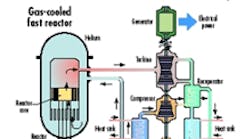This helium-cooled, closed-fuel cycle reactor features a relatively high coolant outlet temperature (850°C), making it efficient at generating electricity or producing hydrogen. It can be fueled with composite ceramics, advanced particles, or ceramic-clad actinide compounds. And cores can be configured based on prismatic blocks, and pin or plate-based assemblies. The design minimizes production of longlived radioactive wastes, and its spectrum lets it use fissile and fertile materials, including depleted uranium, more efficiently than thermal spectrum gas reactors with once-through fuel cycles. |
This reactor is sodium cooled with a closed fuel cycle. It can be used to manage high-level wastes, particularly plutonium and other actinides. Its safety features include a long thermal response time, a large margin between the coolant (sodium) working temperature and its boiling point, and a primary system that operates near atmospheric pressures. There's also an intermediate sodium system between the radioactive sodium in the primary system and water and steam in the power plant. |
This reactor relies on lead or lead/bismuth eutectic liquid-metal cooling. It can be optimized for a range of different plant ratings, including a 50 to 150 MWe design with a long refueling interval (15 to 20 years), a modular system with 300 to 400 MWe, or a large monolithic plant putting out 1,200 MWe. Fuel is a metal or nitridebased material containing uranium and transuranics. It is cooled by natural convection and has a coolant outlet temperature of 550°C, which might be raised to 800°C with advanced materials. (The higher temperature would make it possible to generate hydrogen thermochemically.) It is well suited for small power grids and developing countries that may not wish to build a fuel-cycle infrastructure to support nuclear energy systems. |
Molten salt reactors use circulating liquid mixes of sodium, zirconium, and uranium fluorides as fuel. (Molten fluoride salts have excellent heat-transfer qualities and low vapor pressures, which reduce stresses on reactor vessels and piping.) The molten fuel flows through graphite core channels, generating heat. This heat moves through a pair of heat exchangers and a secondary cooling system before being used to generate electricity. Output for an optimally sized plant is currently 1,000 MWe and outlet temperatures are about 700°C, but could be boosted to 800°C for added efficiency. |
Supercritical water-cooled reactors are high-temperature, high-pressure, water-cooled systems that operate above the thermodynamic critical point of water (374°C and 22.1 MPA or 705°F and 3,208 psi). Supercritical water coolant gives the design a thermal efficiency one-third higher than current light-water reactors. Plant design is simplified by using coolant that does not change phase in the reactor and is directly coupled to the energy conversion equipment. The reactor is fueled by uranium oxide. |
The very-high-temperature reactor is graphite moderated, helium cooled and uses uranium as fuel. Its main output is heat, which it supplies at 1,000°C, hot enough to be used for hydrogen production. The reactor core can be a prismatic block, as in Japan's operating HTTR reactor, or a pebble core, as in China's operating HTR-10 reactor. It can generate electricity as well as heat in cogeneration configurations. |
Samuel Badman, U.S. Secretary of Energy, and representatives from Canada, France, Japan, and the U.K. signed an agreement to allow the five countries to research and develop next-generation reactors on a global level. This framework agreement will let countries in the Generation IV International Forum (GIF) go beyond coordination of research and begin joint research projects all over the world. The agreement should let GIF countries conduct nuclear-power research more effectively by using resources and expertise in the international community. Other GIF participants include Argentina, Brazil, the EU, South Africa, South Korea, and Switzerland.
"Each of our nations recognizes that developing new nuclear power technologies will be indispensable in meeting our growing needs," says Bodman. "This research agreement will accelerate international efforts to develop nuclear technologies that will be safer, more cost reliable, cost effective, and more proliferation resistant than any technology available today."
The GIF partners have identified six technologies for development: gas-cooled fast reactor, sodium fast reactor, lead-cooled fast reactor, molten salt reactor, supercritical water reactor, and the very-high-temperature reactor. The U.S. will likely take the lead in developing the very-high-temperature reactor.
